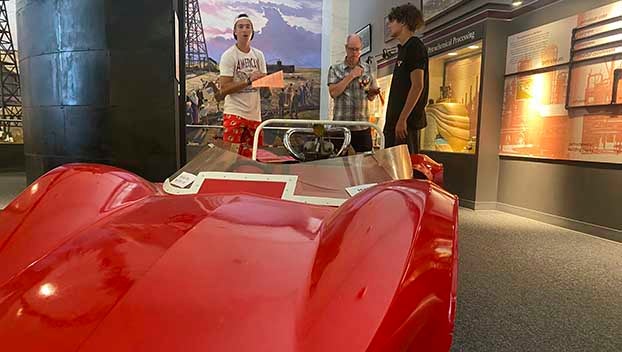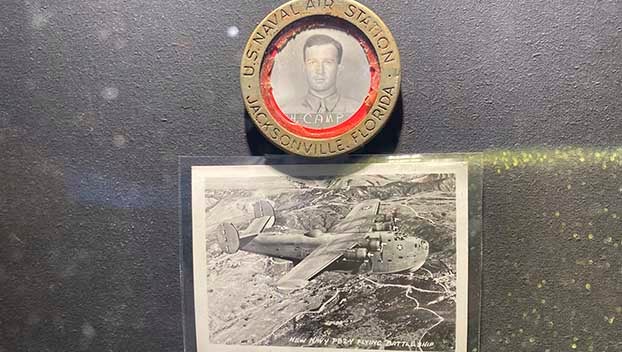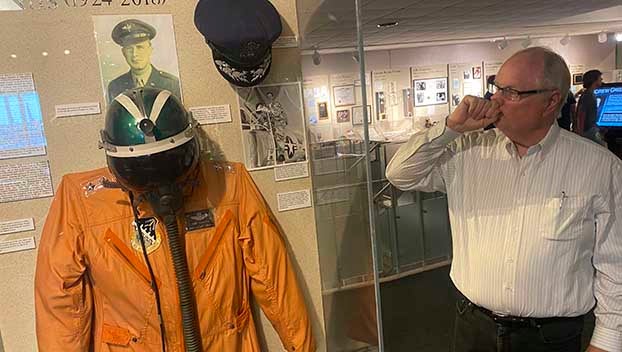CELEBRATING 125 YEARS — See how Port Arthur’s influence is felt worldwide
Published 12:40 am Saturday, May 20, 2023

- Levi Wright, right, and Noah Miller talk with Museum of the Gulf Coast Curator Robert Fong Friday. Near them is a race car designed by Port Arthur native Andrew Green. (Monique Batson/The News)
|
Getting your Trinity Audio player ready...
|
Port Arthur was founded on the idea of revolution.
Arthur Stilwell created a railroad for a north-south corridor to ship goods and services worldwide.
But many of the people who hail from his town have since gone on to change the world.
Andrew Green
Green is credited with creating the first successful composite chassis for automobiles. The longtime sailor had been building sailboats for years when he was approached to create something never before seen — an automobile that wasn’t made of metal.
It started with a man in Midland irritated by consistently losing the Grand Prix.
“He was complaining to a salesman — the metal frame lacks curves and can’t win the race,” said Tom Neal, director of the Museum of the Gulf Coast. “The salesman says we can’t afford General Dynamics, but I know a guy.”
Green agreed to use composite materials to create a car body that was five times stronger than metal.
“They were just about finished with it,” Neal said. “They called GM and said, ‘by the way, we built a plastic car.’ And (GM) said, ‘Congratulations, you just lost the race.’ And Andy said tell them to come see us in about four weeks.”
And so they did.
“They said, ‘What in the world have you done? We’ve never seen anything like this,’” Neal said.
Green created the Chaparral, which won the Grand Prix.
Later the Port Arthur native would be approached again, but this time not for an automobile.
“When computers came out — PCs — two guys on the east coast died while sitting in front of their PCs,” Neal said. “Their pacemakers were interrupted. And the government shut down all sales of PCs. One guy wasn’t’ going to wait around for all that, and he’d heard of this guy.”
He wanted a building constructed from the ground up using composite materials that contained no metal whatsoever. And Green delivered.
“What’s funny about this thing is they featured his construction of total composite, a non-metal building, on the front of ‘Modern Metals,’” Neal said.

During WWII, Jack Camp found a Japanese fleet headed for the United States. (Monique Batson/The News)
Jack Camp
Born in 1916, Camp was a pilot in the U.S. Naval Reserve when WWII began. While in the air, he spotted a Japanese fleet that was headed for the United States.
“This guy’s from Port Arthur and found a Japanese fleet that changed everything,” Neal said. “They were doing everything they could to figure out where they were. The whole fleet was traveling together and they couldn’t find them, but they worried when they showed up about the damage they would do. And a guy from Port Arthur enters the story.”
Camp’s aircraft was shot down, ultimately resulting in his death.
J.P. “The Big Bopper” Richardson
His death will forever be known as “The Day the Music Died.” But Richardson, who was born in Sabine Pass, created something more than music before his fatal plane crash in 1959.
According to Guinness World Records, Richardson “is credited with producing the first examples of a ‘music video.’”

Museum of the Gulf Coast Director Tom Neal stands by Gen. Harold Collins’ flight suit. (Monique Batson/The News.
Gen. Harold Collins
This Port Arthur native was the first person to fly the first “Sonic Boom” for world media. His flight suit is on display at the Museum of the Gulf Coast.
“Look at the helmet,” Neal said. “You see the crack on the side? His head hit the canopy. That’s how rough and tough all these guys were.”

Robert Rauschenberg designed the 1983 Grammy-winning album “Speaking in Tongues” by the Talking Heads. (Monique Batson/The News)
Robert Rauschenberg
Credited with creating modern expressionism, Rauschenberg is also said to be an inspiration for Andy Worhol. Rauschenberg designed the 1983 Grammy-winning album “Speaking in Tongues” by the Talking Heads. In the museum is an entire room of his work, all signed and organized by Rauschenberg himself.
But recently the room has taken on a new meaning.
In 2019, a Rauschenberg painting sold for $88.8 million.
Neal said the highest he’d seen a Vincent van Gogh painting sell for was $81 million.
In a recording, the artist explains his decision to leave his hometown.
“You don’t choose to be an artist, and I don’t think you learn to be an artist either,” he said. “It was not acceptable in Port Arthur, Texas to be anything other than everybody else. And I didn’t know how. So that gave me a head start.”
Rauschenberg had dinner with Janis Joplin the night she died.
Clifton Chenier
Chenier came to Port Arthur in the mid-1940s to work at Gulf refinery.
“They were there working and they’d play at lunch so they brought their instruments to work,” Neal said. “His brother…would wear a rope around his neck tied to a scrub board.”
Soon they drew a design in the dirt and asked coworker Willie Landry if he could make it. Landry, who was a metal craftsman, did.
And that became the first frottoir.





